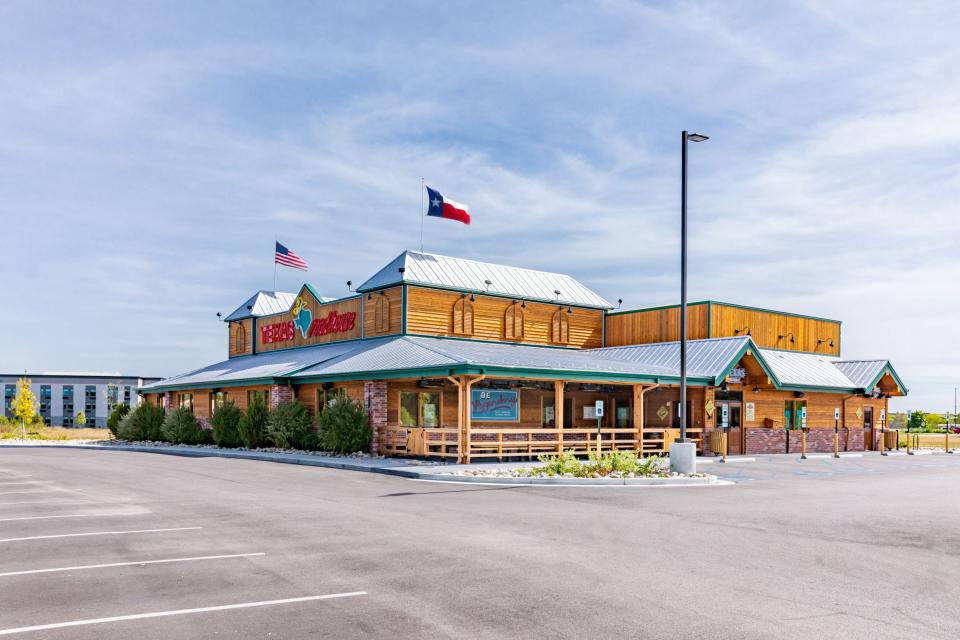Tastes like Texas? Tell us the dish(es) you think best rep our big giant state
On May 11, 1977, Texas adopted chili as the official state dish.
The legislative language included this paean: “One cannot be a true son or daughter of this state without having his taste buds tingle at the thought of the treat that is real, honest-to-goodness, unadulterated Texas chili.”
Wait. No barbecue? No tacos? No steaks?
Off the top of my head, I can think of a couple dozen candidates for quintessential Texas dishes.
These thoughts drifted through my consciousness as I pondered another column that requires your ardent opinion: What is the quintessential Texas dish? Or should it be dishes?
You've already helped me build multiple columns based on the best Texas songs, books and movies.
Now please send a description of the dish you think exemplifies Texas — and why — to mbarnes@statesman.com.

Serving up Texas authenticity
Adapting some guidelines published long ago by my colleague, restaurant writer Matthew Odam, I'll pass along these tips about seeking Texas authenticity on the plate:
Look for Texas ingredients.
Reflect wisely on the complex nature of Texas cultures, indigenous and immigrant, never purely one thing, always a mixture of the many.
Texas history, delivered to your inbox
Click to sign up for Think, Texas, a newsletter delivered every Tuesday
Informed by a lifetime of road trips that always included fanatical quests for local grub, allow me to submit some candidates for top Texas dish.
Tacos: My totally unscientific research into the state's roadside dining establishments concludes that any town with 1,000 residents — and many without that total — host, along with a doughnut shop, a Mexican restaurant. Many of them serve Tex-Mex in particular. And among the most common dishes is the humble taco.
A taco is a tortilla, flour or corn, plus whatever is served inside, or on top of it. By that definition, as much as half the menu at a typical Tex-Mex eatery can be a taco of some sort. Thus, like its cousin, the sandwich, the taco is open to thousands of modifications. It can be hardy and portable, or dainty and refined. You can purchase it from a truck parked in front of a construction site, or at the most fashionable restaurant in town.
Barbecue: Almost all the cultures that make up Texas smoke meat slowly. Beef predominates in West and Central Texas, while pork and chicken pop up elsewhere, especially in East or North Texas. Asian and Mexican barbecue are all the rage in some regions.
Since I live in Austin, I try the non-beef options while on the road.
Yes, you can smoke vegetables and other non-meats, but you are not going to find those items on the menu at a screened-in joint located on a two-lane blacktop miles from a city.
Cities, however, are playing a larger role these days in barbecue culture. Used to be, we city folk left the slow, patient work of smoking meat in large quantities to places where life was suited to the pace of barbecue. No longer. Some of the best of today's pit masters can be found in urban areas.
I'm not going to get into the endless discussions over which culture — Spanish, Mexican, German, Czech, Black, Southern, Midwestern — most influenced Texas barbecue. At the same time, although I've learned a lot from other barbecue hotspots around the country, especially the Carolinas, I'm a confirmed proponent of the Texas product.

Chili: Many Texans my age associate this dish made of roughly ground and stewed meat with Wolf Brand Chili, developed in 1895 by Lyman T. Davis in Corsicana. He sold it for 5 cents a bowl from the back of a wagon parked on the streets in downtown Corsicana.
"He later opened a meat market in Corsicana where he sold his chili in brick form, using the brand name of Lyman's Famous Home Made Chili," reports the Handbook of Texas Online. "In 1921, using the simplest machinery, he began canning his chili and marketing it in the immediate area. It was about that time that he adopted the brand name 'Wolf Brand,' in honor of his pet wolf, Kaiser Bill."
Wolf remained a Texas-only brand until 1954, the year I was born, when it was exported out of state for the first time. Another popular product of my youth, AusTex Chili, was once canned in factories right in the middle of downtown Austin in a district known informally as "Mexico" near "Chili Square."
Although Texans still hold competitive chili festivals and restaurants serve cups and bowls of the reddish brown stuff, I sense a decline in its popularity, even with the advent of vegetarian or vegan versions. I still make chili con carne from scratch — use plenty of cumin — on cold winter afternoons. Add shredded cheddar cheese and chopped white onions with saltines on the side and I'm transported back to younger days.
More:St. John Colony, Texas, celebrates 150 years of Juneteenth jubilees
Chicken-fried steak and more: I hesitate to include this comfort food that could be ordered at almost any Texas diner during my youth because I don't see chicken-fried steak — I'm a cream gravy guy — on the menu that often anymore. And quite frankly, the results are hit or miss, based mainly on the quality of the meat.
A restaurant near us serves a $32 chicken-fried steak. I'm not allowed to order it.
What about burgers? That's one dish you can find almost anywhere in Texas. Yet that doesn't make it special. You can obtain a good or even great burger almost anywhere in the country.
My short list of state food includes pot roast, pecan pie, ribs, casserole, pulled pork, corn dogs, shrimp (variously prepared), sheet cake, queso, stew, enchiladas, pork chops, rare steak, tamales, fried okra (almost the only way to eat the darn things), fried chicken, Frito pie, salsa, black-eyed peas, greens cooked in bacon fat, fajitas and kolaches. Plenty of Asian dishes belong here — Vietnamese pho, for instance, rivals chili con carne among my cold-weather longings these days.
Texans love their native dishes so much that the popularizer of the fajita, Juan Antonio “Sonny” Falcón, was buried with honors at the Texas State Cemetery.
To inspire your senses before you share your Texas nominations, here's what I wrote about Sonny's invention, reported from his East Travis Heights home in 2019 shortly before his death:
The beef slides off the sharp knife like silk off silk.
The cooks, father and son, add no rub or marinade to the outside skirt cut. Instead, they gently drape the fillets over a small, very hot outdoor grill fueled by coals and thick staves of wood. They flip the meat constantly for six to eight minutes. Then they combine the meat and juices in a heated slow cooker before fanning out the cuts on a wide cutting board.
In seconds, they are rendered into “little sashes,” or “fajitas.”
Driven by the urgent, smoky scents, the hungry guest forks a juicy fajita onto a standard-size flour tortilla and then tops those earthy elements with a dash of salt and a generous sprinkling of homemade hot sauce.
Heaven.

Big appetites, big portions
Before leaving the subject of Texas food altogether, I will admit I have never dined at one of the 609 Texas Roadhouse locations, or the 571 LongHorn Steakhouses.
On any Texas road trip, I'm much more likely to seek out local options rather than stop at a chain restaurant along a freeway.
Yet as a journalist who is curious about all things Texan, I should be more alert to what corporate American thinks is Texas food. After all, they might be right.
It will surprise no one that neither Texas Roadhouse nor LongHorn Steakhouse were created or fostered in the state.
No problem there. One does not have to live in Japan to dream up a fabulous sushi spot, or be born in Italy to make perfect risotto.
More:Austin Food & Wine Festival will Rock Your Tacos again and adds a wurst-themed kickoff
Texas Roadhouse was founded in 1993 at a mall in Clarksville, Indiana, and is headquartered in Berlington, New Jersey. The first LongHorn Steakhouse opened in 1981 on Peachtree Street in Atlanta and is owned and operated by Darden Restaurants Inc. out of Orlando, Florida.
Perusing their online menus and other digital evidence, the portions at these eateries live up to one of the state's deeply held identities: They are big.
Perhaps not as generous as those at Outback, but then again, Australia is quite a bit bigger (almost 3 million square miles) than Texas (268,597 square miles).
Scrolling through the menu options, one need not press the vintage ad's question: "Where's the beef?"
It is all over the place.
I counted as many as 20 beef dishes served at Texas Roadhouse, eight of them from the "Hand Cut Steaks" section. For its part, Longhorn Steakhouse offers at least 20 beef selections from its kids, lunch and dinner menus, a whopping 13 of them in the "Legendary Steaks and Combos" section.
This emphasis not only comports with the state's cowboy mythology, but also our cultural roots going back to the first Spanish beeves that were ranched in the South Texas brush country during the 1700s.
Both chains serve numerous chicken dishes, including classic fried chicken, and a few seafood options, mostly shrimp and salmon along with lobster, as well as starters, sides, desserts and drinks. The Roadhouse also proffers the choice of mix-and-match plates in its "Texas Size Combos" section, which harks back to the "Surf and Turf" craze of my early adult days.
What's missing? Not many Mexican or Tex-Mex options here. A few kisses are blown in the direction of barbecue, but barely a hint of Cajun or soul food. Those influences seem pretty Texan to me.
Unapologetically, these are steakhouses. There's nothing wrong with that. As an omnivore, I have no problem admitting that these menus made my stomach growl. My vegetarian road trip buddy, however, would have to work his way around the mountains of animal protein that at times appear recklessly added to dishes that don't need it.
More:Texas forever: How to set up a memory page online for your favorite city
The lesson: Steak is definitely a candidate for the state's quintessential dish.
Texas steaks can be delicious, but I've enjoyed some cuts that were as tender as a mother's love in joints from Chicago to Florence, Italy. The achievement is not ours alone.
Which of our two big chains is more Texan? I'd have to vote for Texas Roadhouse, not because of the decor or food, but rather, thanks to the company's perceptive partnership with Willie Nelson. A shrine to the great man, dubbed "Willie's Corner," can be found in every location.
Nobody is going to argue with Willie.
Michael Barnes writes about the people, places, culture and history of Austin and Texas. He can be reached at mbarnes@statesman.com. Sign up for his weekly history newsletter, Think Texas, at statesman.com/newsletters.
This article originally appeared on Austin American-Statesman: Barbecue, tacos, chili? What food or dish tastes the most like Texas?

